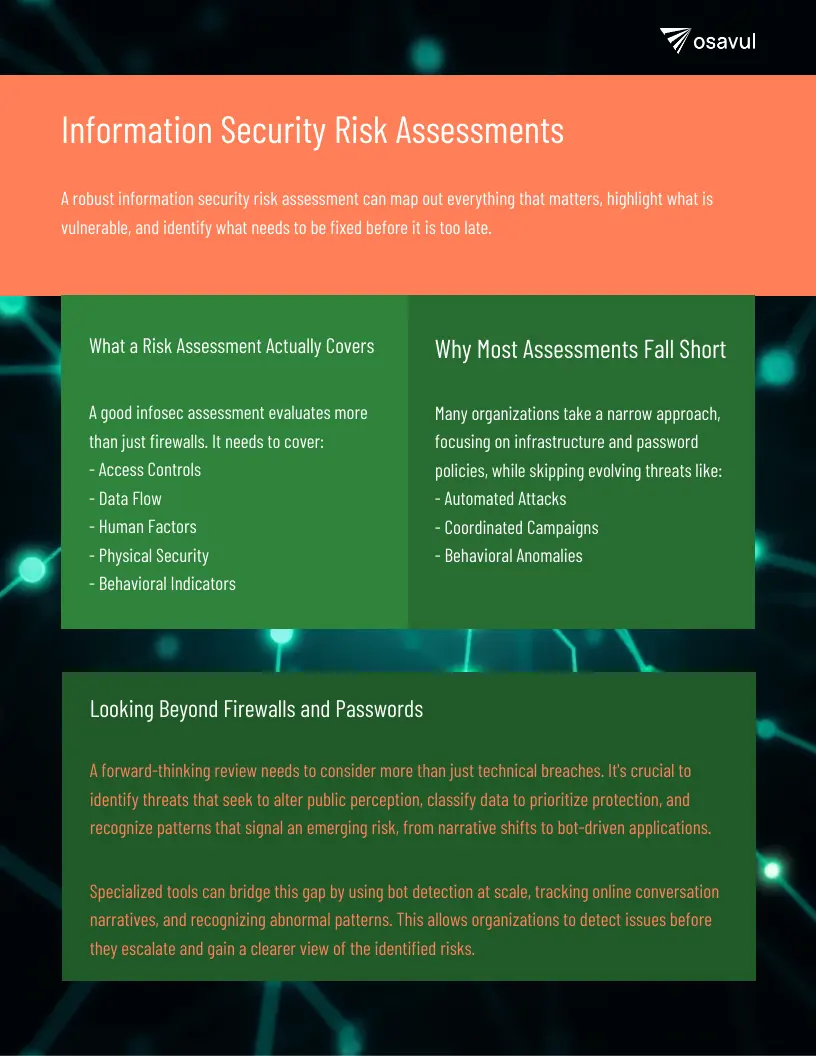When it comes to modern tech, security risks don’t always come from where you might expect. A robust information security risk assessment can map out everything that matters, highlight what is vulnerable, and identify what needs to be fixed before it is too late. With today’s world being so digitally connected, these threats aren’t just about technical breaches; they are also about data handling practices, user behavior, and coordinated online influence campaigns. It’s a much more complicated issue of infosec vs cybersec.
When executed correctly, a risk assessment information security plan can act as both an early warning system and a plan of action for reducing weaknesses. On the other hand, if done poorly, it ends up being just a box-ticking exercise that overlooks the underlying issues causing the most harm.

When asked the question ‘what is information security risk assessment?’, most people’s minds will go straight to things like encryption, firewalls, and antivirus tools. Though these elements are certainly important, they are only a small part of the whole picture. A much broader and complete approach is needed to address the wider ecosystem involving your systems and data.
A good infosec assessment needs to evaluate:
Who is able to get into sensitive systems and files, and under what protocols and conditions?
Everything to do with where your information is stored, how it moved from place to place, and if there are any points of weakness on that journey.
A focus on training and raising awareness for staff, with an emphasis on understanding how to follow secure processes.
Assessing alarms, locks, and any controlled access to the critical hardware.
Tracking activity that might suggest attempts at disruption or manipulation.The process is about more than technology, also factoring in how systems and people interact with data.
The entire risk assessment process also accounts for contractual requirements, compliance obligations, and sector-specific regulation.

Compared to the guidance of the EDPS about information security, too many organizations still take a very narrow approach in this field. Traditional information security risk assessment puts too much focus on infrastructure and password policy, often skipping some of the more important aspects in the fast-evolving threat landscape, such as:
Bots are able to launch high-volume login attempts, along with spreading harmful narratives in a matter of minutes.
Groups that seek to deliberately disrupt operations and damage trust.
Patterns of unusual traffic or any sudden changes in the tone or sentiment of online discourse.
Taking too shallow an approach that leads to missing potential threats that fit into the classic definition of a cyber attack. For example, a well-executed coordinated bot attack can succeed in undermining confidence in a chosen brand without ever having breached a single server.

Another crucial element of answering the question ‘what is information security risk assessment?’ is highlighting the context just as much as the technology. Any forward-thinking review needs to consider the following:
• How to identify threats that seek to alter public perception, not just the integrity of a system.
• How to classify data in order to prioritize the assets that are worth the most protection.
• How to recognize patterns that signal an emerging risk, from narrative shifts to bot-driven applications to fake accounts and more.
It is in this area that some organizations tend to falter, putting more focus on keeping outsiders out, but forgetting that things like external influence campaigns can be just as damaging as traditional breaches.
A smart way to bridge this gap is by using specialized tools like those provided by Osavul. Osavul’s bot detection software is designed to spot the more non-traditional risks.
Identifying coordinated bouts of automated activity that could suggest a targeted campaign.
The monitoring of shifts in online conversation could lead to detecting potential harmful trends at an early stage.
Flagging traffic and posting anomalies that even slightly deviate from the expected norms.
Through integrating Osavul, organizations can detect issues before they start to escalate. Dashboard reports can be created that give teams a much clearer and more concise view of the identified risk.
Ultimately, a robust information security risk assessment should be seen as proactive rather than simply reactive. It should be able to identify what is coming instead of what has already happened. In expanding the scope to include both the technical and the behavioral, organizations are much better able to safeguard themselves.
Using powerful tool suites like Osavul’s bot detection platform helps to provide a much deeper level of online activity tracking, pointing towards hidden campaigns and emerging weaknesses. When combined with a well-structured risk assessment process and a better culture of awareness within a team, this approach is the best way to ensure that organizations can stay ahead of both traditional and untraditional risks.